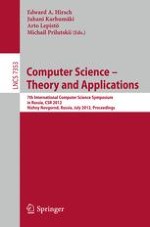2012 | Buch
Computer Science – Theory and Applications
7th International Computer Science Symposium in Russia, CSR 2012, Nizhny Novgorod, Russia, July 3-7, 2012. Proceedings
herausgegeben von: Edward A. Hirsch, Juhani Karhumäki, Arto Lepistö, Michail Prilutskii
Verlag: Springer Berlin Heidelberg
Buchreihe : Lecture Notes in Computer Science
